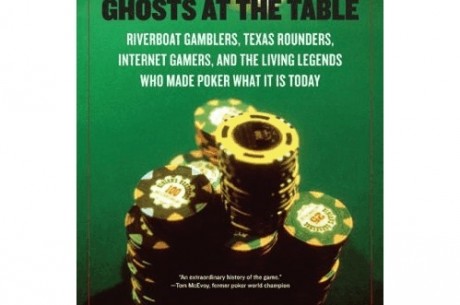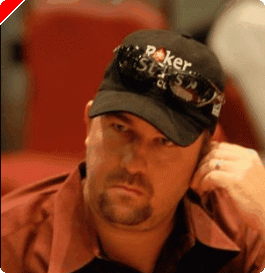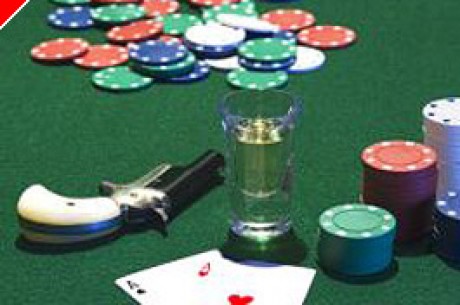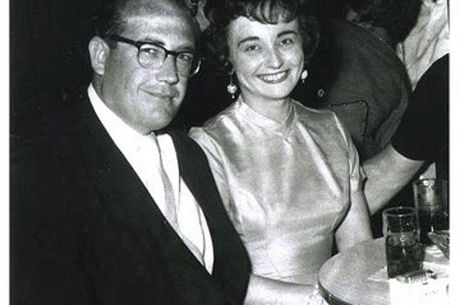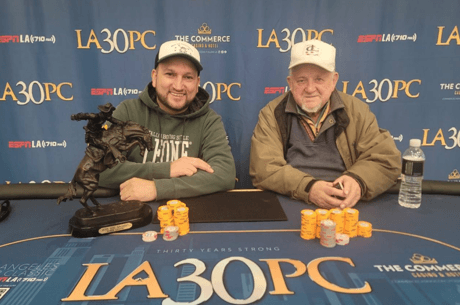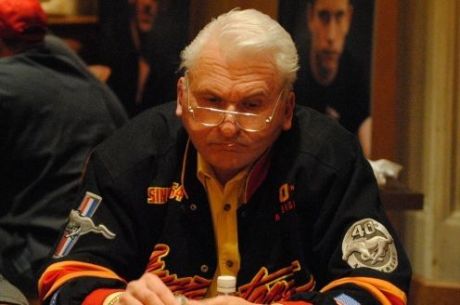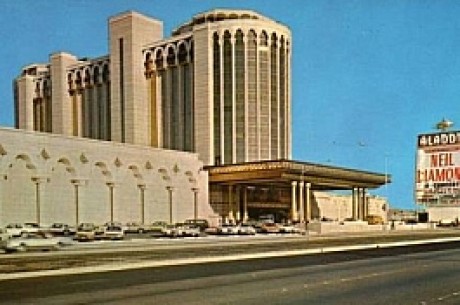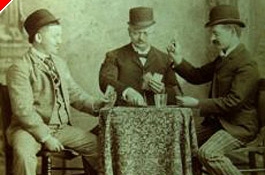Poker & Pop Culture: Moss & Dandolos, Dazzling with Dollars
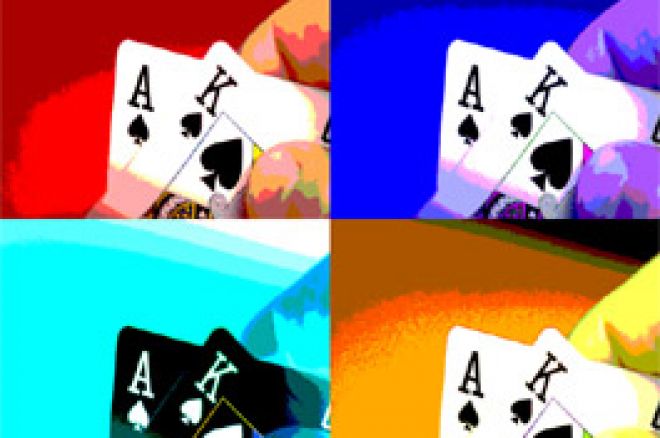
This series of columns will discuss and analyze the ever-changing position poker has occupied in American popular culture. We'll look back to earlier periods in poker's history, shedding light on how the game's relationship to society has changed over time by examining important moments in the development of that relationship. The moments on which we'll focus are ones when poker, for a variety of reasons, successfully attracted the attention of the general public �� a.k.a. "the straight world" (depending on one's point of view) �� briefly rising to the surface of the cultural mainstream.
Such occasions certainly reveal a lot about America's ever-shifting views of poker and its various (moral, political, social, economic) significances. These occasions also tell us something important about America, more generally speaking, insofar as they touch upon certain values and ideas that tend to define the nation, for better or worse. As the great comedic actor Walter Matthau once wryly suggested of poker, "(T)he game exemplifies the worst aspects of capitalism that have made our country so great."
We'll start with an event whose historical authenticity has been much debated, but has nevertheless endured as a much-referenced, influential episode in the development of professional or "legitimate" poker. It is also a quite literal example of poker being presented to a wider audience, being made a spectacle for the non-poker playing public to witness �� the legendary, high-stakes, heads-up poker match between Johnny Moss and Nick "the Greek" Dandolos at Binion's Horseshoe.
The Lure of High Stakes (It Doesn't Take an Einstein to See)
Like most legends, the story of the match is riddled with dubious details and (likely) extreme embellishments. Even the date is in doubt. In any case, most of those who have considered the matter closely tend to agree some sort of match did occur between Moss, the established veteran of the Texas poker wars who'd go on to win nine WSOP bracelets, and Dandolos, the Crete-born, high-rolling gambler who'd made a fortune in banking and real estate and now was in search of the biggest games from coast to coast.
Benny Binion had arrived in Las Vegas in 1946, having essentially fled Dallas where a checkered past of bootlegging, theft, and illegal gambling had finally threatened to catch up with him. With a partner, Binion soon took over the Las Vegas Club, though Binion would eventually break with his partner and purchase the El Dorado casino on Fremont Street, renaming it Binion's Horseshoe.
Soon thereafter, the story goes, Dandolos arrived in Vegas in search of "the biggest game this world can offer," and not so coincidentally found himself in touch with Binion, the new casino owner whose mark upon early Vegas was largely summed up by the sign he'd hung above the Horseshoe's front door: "THE WORLD'S HIGHEST LIMITS." Binion could help Dandolos. The Horseshoe would be the perfect location for such a game, and Binion knew just the man to pit against the high-rolling action-seeker.
Binion phoned his longtime friend Moss back in Texas, convincing him to leave his current game and come to Vegas to play Dandolos with a bankroll provided by Binion. Moss arrived �� probably in early 1951 (although Moss himself once told a biographer it was 1949) �� and soon he and Dandolos were engaged in what would become a lengthy heads-up poker match that included several variants of the game, with five-card stud apparently the most prominent.
Further details of the match can be found in numerous places, with most of those accounts tending to agree upon a few particulars. The stakes were certainly high. Most versions describe a particular hand of five-card stud, won by Dandolos, in which the pot exceeded half a million dollars. In addition to the test of nerves potentially caused by the huge pots, the match was also a test of stamina, with the pair playing four and five days at a time without a break, and the entire match lasting several months. Apparently tourists were occasionally permitted to take one or the other player's seat, buying in for a minimum of $10,000, though those members of the game's supporting cast never stayed for very long. Dandolos took an early advantage, but ultimately Moss would end well ahead, and in most versions is said to have taken more than $2 million off his opponent.
A most intriguing aspect of the story �� and one that is least possible to verify �� is the way the Moss-Dandolos match attracted onlookers, a phenomenon Binion may or may not have anticipated. Early on, Binion relocated the game to a more conspicuous place near the casino's front entrance where the gathering crowds would additionally draw foot traffic from those passing by the Horseshoe. Writes Anthony Holden in Big Deal, "the crowd stood six deep around the table, marveling at the nerve and stamina of these two poker titans, and at the vast amounts of money passing back and forth between them." In a recent CardPlayer article about the game, James McManus says "their table was soon hemmed in by chattering audiences of 200 or 300." To the delight of Binion, many of those coming in to watch stayed to gamble elsewhere in the casino.
The game also reportedly attracted the attention of a certain German-born, Nobel Prize-winning physicist who had relocated to the U.S. to live out his last years �� Albert Einstein. Legend has it that during one break in the action, Dandolos and Binion took a walk with Einstein up and down Fremont Street, introducing him to their fellow pedestrians as "Little Al from Princeton," someone who "controls a lotta the action around Jersey."
At some point, some four or five months after the game had begun (say most), Dandolos finally stood from his chair and said "Mr. Moss, I have to let you go," thereby cutting his losses and ending the epic encounter.
How the Biggest Game Went Down in History
In terms of cultural impact, while the benefits of the match were likely immediately apparent to the Horseshoe and downtown Vegas, its influence cannot reasonably be said to have extended much further for at least a couple of decades. Michael Craig has noted that no extensive accounts of the game appeared until the 1970s, not even in books devoted to the two participants. Indeed, it was not until Al Alvarez included an account of the game in The Biggest Game in Town (1983) that it began to receive widespread attention, ultimately being built into a seminal event in modern poker history.
The belated revival of interest in the match can largely be traced to Alvarez, both for having told of it in Biggest Game and for his suggestion there that "the idea of" the World Series of Poker "originated" with the Moss-Dandolos match. That's a claim Des Wilson flatly refutes in Ghosts at the Table (2008) �� "it did not inspire the launch of the World Series," says Wilson.
Nevertheless, the two events do share more than just a similar venue. Both the Moss-Dandolos match and the first WSOP, hosted at the Horseshoe in 1970, involved Benny Binion inviting high-stakes playing poker friends to come play poker at the Horseshoe, thereby enabling him to attract customers to his casino. And in both cases, the sheer magnitude of the money being wagered provided the primary draw �� it was the money, even more so than the game being played, that most spurred the fascination of the general public.
Raising the stakes was always part of the story of Binion's Horseshoe. On its opening, $50 was the highest limit available in Vegas for craps. At the Horseshoe, Binion made it $500. When Alvarez visited in the early 80s, he reported that Binion's was then the only casino where one could play hold'em with no limit whatsoever. And, of course, Binion also literally used the sight of cash to draw customers with his famous million-dollar display �� one hundred $10,000 bills encased in a eight-foot high, 2,000 lb. glass horseshoe. That display was purchased by a collector and removed in 2000, but just last month a new one was installed at Binion's, an acrylic pyramid full of bills positioned in the middle of the casino.
The Moss-Dandolos match staged at Binion's has other parallels from later poker history as well, all likewise demonstrating the allure of high-stakes gambling to the general public. There are Andy Beal's famous heads-up matches versus the syndicate of pros, spun into a well-received, gripping narrative by Michael Craig The Professor, the Banker, and the Suicide King. There's the "Big Game" in Bobby's Room at the Bellagio, of which Marco Traniello once wrote in CardPlayer it was "surreal looking at the faces of the people who are watching the the game for the first time from behind the glass. They are both in awe and sometimes in shock, watching millions of dollars change hands." And there are the many popular television shows such as "High Stakes Poker," "Poker After Dark," and the WPT and WSOP telecasts that all likewise follow in the tradition of dazzling with dollars first forged back in that mid-century match at Binion's.

